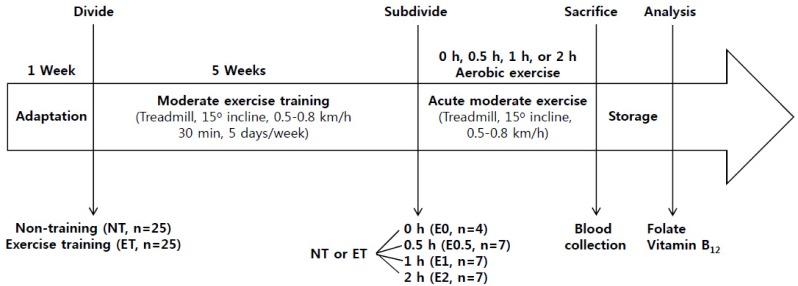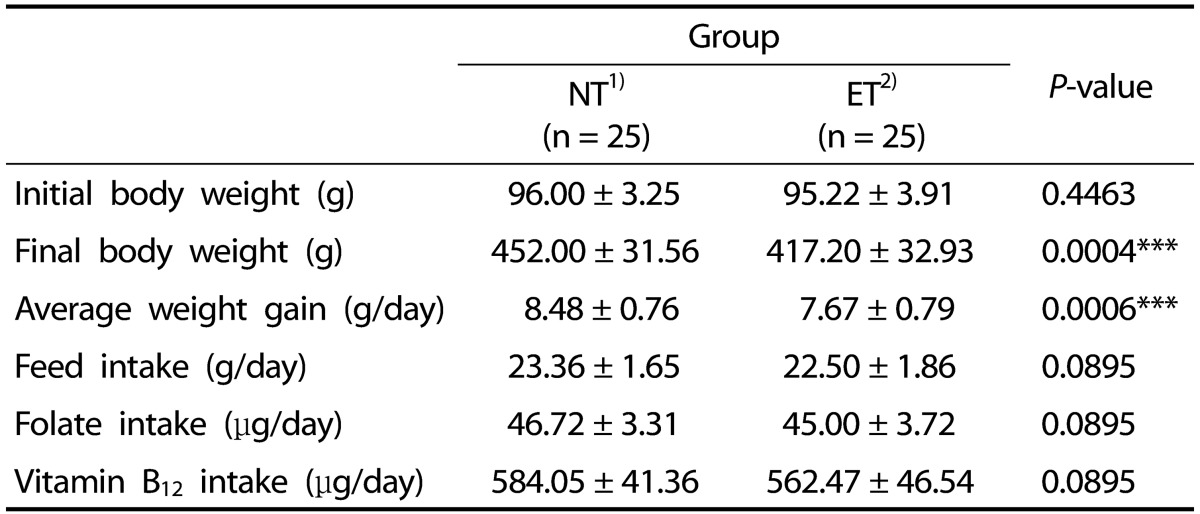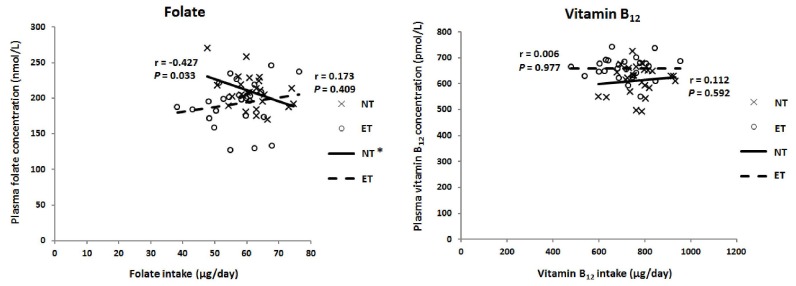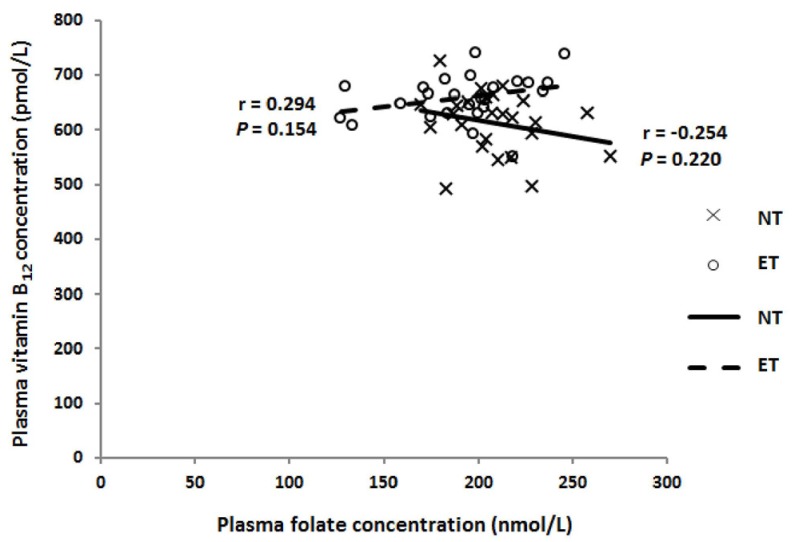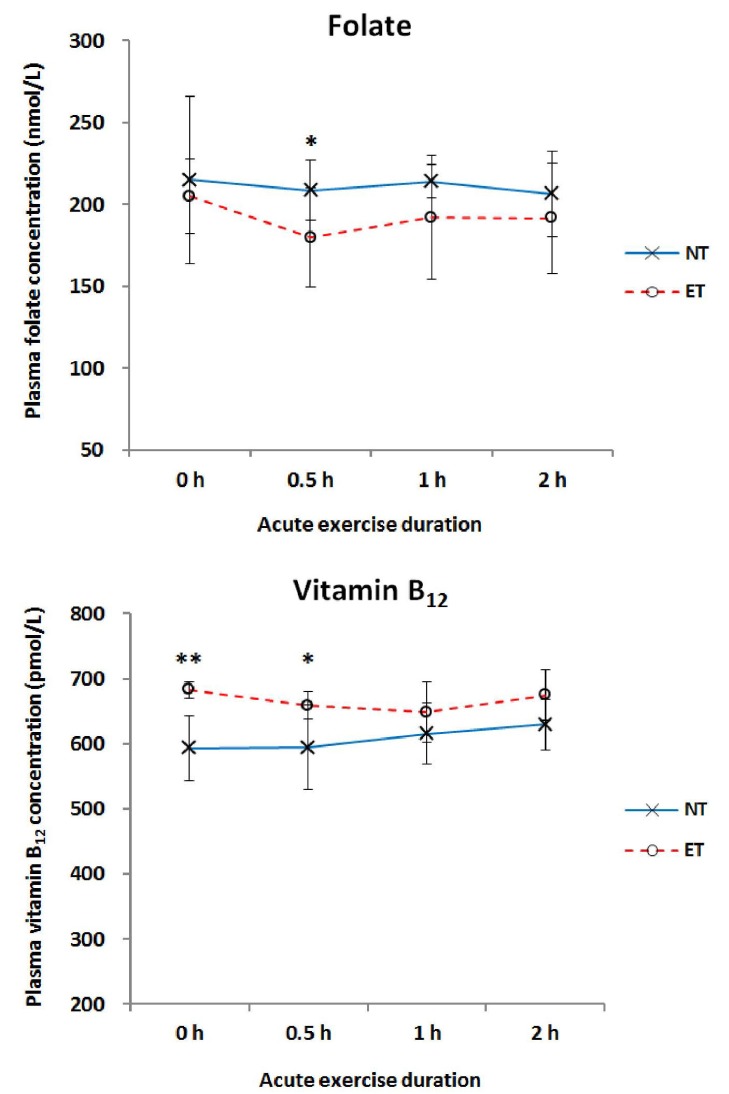Abstract
BACKGROUND/OBJECTIVES
Energy production and the rebuilding and repair of muscle tissue by physical activity require folate and vitamin B12 as a cofactor. Thus, this study investigated the effects of regular moderate exercise training and durations of acute aerobic exercise on plasma folate and vitamin B12 concentrations in moderate exercise trained rats.
MATERIALS/METHODS
Fifty rats underwent non-exercise training (NT, n = 25) and regular exercise training (ET, n = 25) for 5 weeks. The ET group performed moderate exercise on a treadmill for 30 min/day, 5 days/week. At the end of week 5, each group was subdivided into 4 groups: non-exercise and 3 exercise groups. The non-exercise group (E0) was sacrificed without exercising and the 3 exercise groups were sacrificed immediately after exercising on a treadmill for 0.5 h (E0.5), 1 h (E1), and 2 h (E2). Blood samples were collected and plasma folate and vitamin B12 were analyzed.
RESULTS
After exercise training, plasma folate level was significantly lower and vitamin B12 concentration was significantly higher in the ET group compared with the NT group (P < 0.05). No significant associations were observed between plasma folate and vitamin B12 concentrations. In both the NT and ET groups, plasma folate and vitamin B12 were not significantly changed by increasing duration of aerobic exercise. Plasma folate concentration of E0.5 was significantly lower in the ET group compared with that in the NT group. Significantly higher vitamin B12 concentrations were observed in the E0 and E0.5 groups of the ET group compared to those of the NT group.
CONCLUSION
Regular moderate exercise training decreased plasma folate and increased plasma vitamin B12 levels. However, no significant changes in plasma folate and vitamin B12 concentrations were observed by increasing duration of acute aerobic exercise.
Keywords: Folic acid, vitamin B12, physical activity, aerobic exercise, rodent
INTRODUCTION
The B-vitamins are particularly important for physical exercise because they are involved in regulation of energy metabolism by modulating the synthesis and degradation of carbohydrates, fats, and proteins. Folate, one of the B-vitamins, is reduced to tetrahydrofolate, serving as an essential cofactor in methylation reactions, including the vitamin B12-dependent formation of methionine from homocysteine, and as a carrier of one-carbon units involved in the synthesis of purines and pyrimidines. The roles of folate and vitamin B12 in assisting with cell division make them critical nutrients for growth, synthesis of new cells, such as red blood cells, and for the repair of damaged cells and tissues [1]. Many methylated molecules (e.g., acetylcholine, creatine, and DNA) are essential for physical activity [2,3,4]. The exercise-induced metabolic demand possibly exerts an increased turnover of many of these substrates. It can be supposed that regeneration of these substrates is accompanied by considerable stimulation of the methionine metabolism [5]. In the degradation of amino acids such as valine, isoleucine, methionine, and threonine and fatty acids, these amino acids are converted to propionyl-CoA and fatty acids are oxidized to acetyl-CoA and propionyl-CoA. Acetyl-CoA enters directly into the tricarboxylic acid (TCA) cycle. Propionyl-CoA is carboxylated to methylmalonyl-CoA and finally converted to succinyl-CoA by methylmalonyl-CoA mutase. This enzyme requires vitamin B12 as a cofactor [6]. Succinyl-CoA is used for energy production in the TCA cycle. Thus, folate and vitamin B12 status and requirements may be altered by energy production and rebuilding and repair of muscle tissue induced by physical activity.
Acute exercise may cause muscular damage and accelerate protein catabolism, which will lead to an increase of muscular amino acid pools and homocysteine production in the methionine metabolism [7]. β-oxidation of fatty acids is a minor component of energy expenditure early in exercise, however sustained exercise at low or moderate intensity requires a substantial contribution of energy from fat oxidation. Physical exercise demands a significant amount of energy turnover and the metabolic pathways for energy production are stressed during exercise. Exercise training induces adaptations to stress during exercise and plays a key role in homeostasis related to an increase in aerobic metabolism [8,9]. Endurance exercise training resulted in increased plasma free fatty acids and free fatty acid oxidation and reduced glucose oxidation [10]. The effects of exercise training in increases of body turnover or requirement of several micronutrients including thiamin, riboflavin, and vitamin B6 have been reported [11,12,13,14]. However, little information is available on the effects of exercise training and acute physical activity on folate and vitamin B12 status.
The aim of this study was to examine the influence of 5-week regular moderate exercise training and duration of acute aerobic exercise on plasma folate and vitamin B12 concentrations in rats. We hypothesized that acute aerobic exercise can decrease plasma folate and vitamin B12 concentrations since folate and vitamin B12 are used as co-factors of methionine and lipid metabolism and the magnitude of this decrease might differ according to regular moderate exercise training and duration of acute exercise.
MATERIALS AND METHODS
Experimental animals and diets
Fifty 4-week old male Sprague-Dawley rats (Daehanbiolink Co., South Korea) weighing 95-105 g were fed a diet which met the AIN-93 recommendations (American Institute of Nutrition). The AIN-93 diet contained 2 mg/kg diet of folate and 25 mg/kg of vitamin B12, respectively. The folate and vitamin B12 intakes of rats were calculated with the amount of feeding and the composition of the diet. Animals were kept individually in stainless-steel cages in a room controlled for temperature (22 ± 1℃), relative humidity (50-60%), and light (12-hour light/dark cycle). The study protocol was approved by the Committee on Animal Welfare Regulations of Duksung Women's University, South Korea (2011-108).
Exercise and collection of samples
Fifty animals were randomly assigned to one of two groups: non-exercise training (NT, n = 25) or regular exercise training (ET, n = 25) for 5 weeks. For exercise training, the rats performed moderate exercise on a treadmill (Jungdo Bio & Plant, JD-A-09, South Korea, 15° incline, 0.5-0.8 km/h) for 30 minutes per day and 5 days per week. Rats who did not engage themselves in running on the treadmill were forced to exercise using light electric shocks. [16]. At the end of week 5, the rats were subdivided into four groups based on exercise duration: non-exercise (0 h (E0), n = 4) and 3 exercise groups (0.5 h (E0.5), 1 h (E1), and 2 h (E2), n = 7 per group). The E0 groups were sacrificed without having performed exercise at the end of week 5. The 3 exercise groups were sacrificed immediately after exercising on a treadmill (15° incline, 0.5-0.8 km/h) for 0.5 h, 1 h, and 2 h, respectively. No deaths occurred during or after exercise in the exercise groups. At each of the respective time points the animals were sacrificed by decapitation under light ether anesthesia. Blood samples were collected and centrifuged at 3,000 rpm for 10 minutes at 4℃. All plasma samples were stored at -70℃ until analysis (Fig. 1).
Fig. 1. Schematic overview of experimental design.
Biochemical analysis
Plasma folate levels were determined by a microbiological method using Lactobacillus casei (ATCC 7469) with a 96-well microplate reader and each sample was analyzed in triplicate [15]. Vitamin B12 concentrations in plasma were analyzed by an enzyme immunoassay using a commercially available kit (Biotain Pharma Co., Ltd., China). Plasma folate levels were expressed as nmol/L and vitamin B12 levels as pmol/L.
Statistical analysis
Data were subjected to an analysis of variance (ANOVA) and followed by Duncan's multiple range test using SAS version 9.4 (SAS Institute, Inc., Cary, North Carolina, US) to determine differences by durations of acute aerobic exercise. In addition, differences between the ET and NT groups were determined using t-test. Pearson's correlation coefficients were calculated to determine correlations between intake and plasma concentrations of folate and vitamin B12 and to find a relationship between plasma folate and vitamin B12 concentrations. Results were considered statistically significant at P < 0.05.
RESULTS
Body weight and folate and vitamin B12 intakes
No difference in the initial body weight was observed between the NT and ET groups; however, the final body weight and average weight gain were significantly lower in the ET group compared with those of the NT group (Table 1). No significant differences in folate and vitamin B12 intake were observed between the groups.
Table 1. Effect of regular exercise training on body weight, feed intake, folate intake, and vitamin B12 intake.
Values are expressed as mean ± SD. *** significant at P < 0.001 by t-test
1) Non-training group
2) Exercise training group
Plasma folate and vitamin B12 concentrations
After regular exercise training for 5 weeks, plasma folate level was significantly lower in the ET group compared with the NT group (P < 0.05), however plasma vitamin B12 concentration was significantly higher in the ET group than in the NT group (P < 0.01) (Table 2).
Table 2. Effect of regular exercise training on plasma folate and vitamin B12 concentrations.
Values are expressed as mean ± SD. * P < 0.05 ** P < 0.01 by t-test
1) Non-training group
2) Exercise training group
Associations between intake and plasma concentration of folate and vitamin B12 and between plasma folate and vitamin B12 concentrations by regular exercise training
Plasma folate concentrations were significantly decreased by dietary folate intake only in the NT group (r = -0.427, P = 0.033). No significant associations between dietary intake and plasma concentration of vitamin B12 were observed in both the NT and ET groups (Fig. 2). No associations were observed between plasma folate and vitamin B12 concentrations in the NT group (r = -0.254, P = 0.220) and the ET group (r = 0.294, P = 0.154) (Fig. 3).
Fig. 2. Effect of exercise training on the associations between intake and plasma concentration of folate and vitamin B12. * P < 0.05 by Pearson's correlation coefficient. NT: non-training group (n = 25) and ET: exercise training group (n = 25).
Fig. 3. Effect of regular exercise training on the associations between plasma folate and plasma vitamin B12 concentrations. No significant correlations were observed by Pearson's correlation coefficient. NT: non-training group (n = 25) and ET: exercise training group (n = 25).
Plasma folate and vitamin B12 concentrations by durations of acute aerobic exercise
No differences of plasma folate levels by durations of aerobic exercise were observed in the NT group (Fig. 4). In the ET group, plasma folate level was the lowest in the E0.5 group; however, there was no significant difference by exercise duration. Plasma folate was significantly lower in the E0.5 group in the ET group than in the NT group (P < 0.05).
Fig. 4. Effect of acute exercise on plasma folate and vitamin B12 concentrations by exercise training. * P < 0.05, ** P < 0.01 by t-test at each duration (0 h, n = 4; 0.5 h, n = 7; 1 h, n = 7; and 2 h, n = 7) between the non-trained (NT) and exercise trained (ET) groups.
In both the NT and ET groups, plasma vitamin B12 concentrations were not significantly changed by increasing exercise duration. Significantly higher vitamin B12 concentrations were observed in the E0 and E0.5 groups of the ET group compared to those of the NT group, respectively. No differences in plasma vitamin B12 levels at the E1 and E2 were observed between the ET and NT groups.
DISCUSSION
This study showed that regular aerobic exercise training for 5 weeks altered plasma folate and vitamin B12 concentrations. However, plasma folate and vitamin B12 concentrations were not altered under different durations of acute aerobic exercise in both NT and ET groups.
Physical activity influences protein metabolism and turnover and thus the concentration of certain amino acids, including methionine [16]. Methionine concentration in plasma increased significantly during exercise and methionine concentration was shown to decrease below basal levels hours after exercise in both humans and rats [18,19]. This finding suggests that decreased plasma methionine after exercise may be due to increased muscle anabolism requiring methionine thus leading to reduced substrate for transmethylation reactions and homocysteine concentration [18,20]. Thus, individuals who participate in regular exercise training may have less folate and vitamin B12 available for methionine metabolism. In this study, we hypothesized that regular moderate aerobic exercise training significantly reduced plasma folate concentration in rats, which may be due to an increased use of folate for methylation including methionine metabolism by physical activity. However, vitamin B12 level was significantly higher in the ET group than in the NT group. In this study, folate and vitamin B12 intakes were similar in the NT and ET groups. Thus, other adaptation mechanisms for exercise training may affect plasma vitamin B12 concentration.
Endurance exercise training results in sparing of plasma glucose and liver glycogen by increasing the oxidation of fat during submaximal exercise [21]. After training, the decreased carbohydrate utilization during exercise is compensated for by an increase in fat oxidation [22]. Mild- or moderate-intensity exercises are associated with a 5-10-fold increase in fat oxidation above resting amounts [23]. The increased capacity to use fat following exercise training results from an enhanced ability to mobilize free-fatty acids from fat depots and an improved capacity to oxidize fat consequent to the increase in the muscle enzymes responsible for fat oxidation [24]. Choi and Cho [25] reported that aerobic exercise trained rats had significantly higher plasma free-fatty acid compared to sedentary rats. The function of vitamin B12 is different from that of folate, which is involved in fat oxidation by acting as a cofactor of methylmalonyl-CoA mutase. Therefore, in this study, an increase in plasma vitamin B12 concentration in the ET group may be due to increased fat oxidation as an exercise adaptation.
In this study, plasma folate and vitamin B12 concentration were also determined by different durations of acute aerobic exercise in the NT and ET groups. Plasma folate concentrations in both groups were not changed by acute exercise duration although there were significant alterations in folate concentration after 5-week training. The acute effect of exercise on protein turnover is catabolic, thus total plasma concentration of amino acids and sulfur-containing amino acids as well as homocysteine is increased after acute physical activity [26]. Thus, during acute exercise, the metabolism requiring folate may not be promoted by increasing exercise duration. However, long-term effects are an overall increase in protein synthesis and lean body mass [27]; therefore, after exercise training, the folate requirement may be increased for formation of methionine from increased homocysteine by acute exercise for protein synthesis and lean body mass. Although vitamin B12 level of each group was not altered significantly by acute exercise duration, vitamin B12 level of the NT group tended to increase by duration. Before exercise and after 0.5-hour acute aerobic exercise, vitamin B12 concentrations were significantly lower in the NT group compared with those of the ET group; however there were no differences in vitamin B12 concentrations after 1-hour exercise. The study conducted by Choi and Cho [25] reported that after 1-hour acute aerobic exercise, plasma free-fatty acids in both exercise trained and sedentary rats were similar although the concentration in exercise trained rats was higher than that in sedentary rats before exercise. Thus, in the current study, an increase in plasma free-fatty acid by aerobic exercise may demand a vitamin B12 influx into plasma from the stored vitamin B12 in the liver for fat oxidation in the NT group.
However, the results of human studies regarding the effects of exercise on plasma folate and vitamin B12 levels are equivocal. Plasma folate was increased during a 3-week training (swimming) period, but dropped after 5 days of recovery training [7]. In physically active subjects, erythrocyte folate and serum vitamin B12 were stable in both a normoxia- and hypoxia-training for 4 weeks [28]. In soccer players, plasma folate concentrations before and after acute high-intensity sprint exercise were similar, but vitamin B12 concentration after exercise was significantly higher than that before exercise [29]. Individuals involved in high intensity physical activity for at least 5 years had slightly higher plasma vitamin B12 concentrations than sedentary individuals [30]. The plasma B12 levels at 6 months in exercising (brisk walking for 20-60 min) women did not differ from those in a control group of similarly afflicted women who did not exercise [31]. Also, vitamin B12 concentrations were not significantly influenced either by 4 weeks of strenuous endurance training or by differences in duration of acute exercise in trained male triathletes [32]. Most human studies were conducted with an uncontrolled diet during experiments and the subjects were already trained before exercise training or acute exercise for the studies, which might have induced the different results. No rat study to find the effects of exercise training and acute exercise on plasma folate and vitamin B12 has been reported.
In conclusion, regular moderate exercise training decreased plasma folate level, but increased vitamin B12 concentration, which might result from the adaptation for exercise training. By increasing duration of acute aerobic exercise, no significant alterations of plasma folate and vitamin B12 concentrations were observed in the NT and ET groups. Further research is needed in order to examine change of folate and vitamin B12 requirements and necessity for supplementation of the vitamins during exercise training and to determine the association of vitamin B12 and fat oxidation for body adaptations of aerobic exercise training.
Footnotes
This research was supported by the 2014 research fund from Duksung Women's University.
References
- 1.Woolf K, Manore MM. B-vitamins and exercise: does exercise alter requirements? Int J Sport Nutr Exerc Metab. 2006;16:453–484. doi: 10.1123/ijsnem.16.5.453. [DOI] [PubMed] [Google Scholar]
- 2.Coyle EF. Physical activity as a metabolic stressor. Am J Clin Nutr. 2000;72:512S–520S. doi: 10.1093/ajcn/72.2.512S. [DOI] [PubMed] [Google Scholar]
- 3.Urhausen A, Weiler B, Coen B, Kindermann W. Plasma catecholamines during endurance exercise of different intensities as related to the individual anaerobic threshold. Eur J Appl Physiol Occup Physiol. 1994;69:16–20. doi: 10.1007/BF00867921. [DOI] [PubMed] [Google Scholar]
- 4.Williams RS, Neufer PD. Regulation of gene expression in skeletal muscle by contractile activity. In: Rowell LB, Shepherd JT, editors. Handbook of Physiology. Section 12: Exercise: Regulation and Integration of Multiple Systems. Oxford: Oxford University Press; 1996. pp. 1124–1150. [Google Scholar]
- 5.Herrmann M, Schorr H, Obeid R, Scharhag J, Urhausen A, Kindermann W, Herrmann W. Homocysteine increases during endurance exercise. Clin Chem Lab Med. 2003;41:1518–1524. doi: 10.1515/CCLM.2003.233. [DOI] [PubMed] [Google Scholar]
- 6.Takahashi-Iñiguez T, García-Hernandez E, Arreguín-Espinosa R, Flores ME. Role of vitamin B12 on methylmalonyl-CoA mutase activity. J Zhejiang Univ Sci B. 2012;13:423–437. doi: 10.1631/jzus.B1100329. [DOI] [PMC free article] [PubMed] [Google Scholar]
- 7.Herrmann M, Wilkinson J, Schorr H, Obeid R, Georg T, Urhausen A, Scharhag J, Kindermann W, Herrmann W. Comparison of the influence of volume-oriented training and high-intensity interval training on serum homocysteine and its cofactors in young, healthy swimmers. Clin Chem Lab Med. 2003;41:1525–1531. doi: 10.1515/CCLM.2003.234. [DOI] [PubMed] [Google Scholar]
- 8.Lira FS, Koyama CH, Yamashita AS, Rosa JC, Zanchi NE, Batista ML, Jr, Seelaender MC. Chronic exercise decreases cytokine production in healthy rat skeletal muscle. Cell Biochem Funct. 2009;27:458–461. doi: 10.1002/cbf.1594. [DOI] [PubMed] [Google Scholar]
- 9.Campbell PT, Gross MD, Potter JD, Schmitz KH, Duggan C, McTiernan A, Ulrich CM. Effect of exercise on oxidative stress: a 12-month randomized, controlled trial. Med Sci Sports Exerc. 2010;42:1448–1453. doi: 10.1249/MSS.0b013e3181cfc908. [DOI] [PMC free article] [PubMed] [Google Scholar]
- 10.von Duvillard SP, Hamrm J, Lyerly GW, Moore JA, Durstine JL. Chapter 3. Utilization of fats in energy production. In: Wolinsky I, Driskell JA, editors. Sports Nutrition: Energy Metabolism and Exercise. Boca Raton (FL): CRC Press; 2008. pp. 47–62. [Google Scholar]
- 11.Kim YN, Choi JY, Cho YO. Regular moderate exercise training can alter the urinary excretion of thiamin and riboflavin. Nutr Res Pract. 2015;10:43–48. doi: 10.4162/nrp.2015.9.1.43. [DOI] [PMC free article] [PubMed] [Google Scholar]
- 12.Choi SK, Baek SH, Choi SW. The effects of endurance training and thiamine supplementation on anti-fatigue during exercise. J Exerc Nutr Biochem. 2013;17:189–198. doi: 10.5717/jenb.2013.17.4.189. [DOI] [PMC free article] [PubMed] [Google Scholar]
- 13.Vallerand AL, Cuerrier JP, Shapcott D, Vallerand RJ, Gardiner PF. Influence of exercise training on tissue chromium concentrations in the rat. Am J Clin Nutr. 1984;39:402–409. doi: 10.1093/ajcn/39.3.402. [DOI] [PubMed] [Google Scholar]
- 14.Crozier PG, Cordain L, Sampson DA. Exercise-induced changes in plasma vitamin B-6 concentrations do not vary with exercise intensity. Am J Clin Nutr. 1994;60:552–558. doi: 10.1093/ajcn/60.4.552. [DOI] [PubMed] [Google Scholar]
- 15.Hyun T, Han YH, Lim EY. Blood folate level determined by a microplate reader and folate intake measure by a weighed food record. Korean J Community Nutr. 1999;4:512–520. [Google Scholar]
- 16.Forslund AH, Hambraeus L, van Beurden H, Holmbäck U, El-Khoury AE, Hjorth G, Olsson R, Stridsberg M, Wide L, Akerfeldt T, Regan M, Young VR. Inverse relationship between protein intake and plasma free amino acids in healthy men at physical exercise. Am J Physiol Endocrinol Metab. 2000;278:E857–E867. doi: 10.1152/ajpendo.2000.278.5.E857. [DOI] [PubMed] [Google Scholar]
- 17.Blomstrand E, Saltin B. BCAA intake affects protein metabolism in muscle after but not during exercise in humans. Am J Physiol Endocrinol Metab. 2001;281:E365–E374. doi: 10.1152/ajpendo.2001.281.2.E365. [DOI] [PubMed] [Google Scholar]
- 18.Mourtzakis M, Saltin B, Graham T, Pilegaard H. Carbohydrate metabolism during prolonged exercise and recovery: interactions between pyruvate dehydrogenase, fatty acids, and amino acids. J Appl Physiol (1985) 2006;100:1822–1830. doi: 10.1152/japplphysiol.00571.2005. [DOI] [PubMed] [Google Scholar]
- 19.Dohm GL, Beecher GR, Warren RQ, Williams RT. Influence of exercise on free amino acid concentrations in rat tissues. J Appl Physiol Respir Environ Exerc Physiol. 1981;50:41–44. doi: 10.1152/jappl.1981.50.1.41. [DOI] [PubMed] [Google Scholar]
- 20.Joubert LM, Manore MM. Exercise, nutrition, and homocysteine. Int J Sport Nutr Exerc Metab. 2006;16:341–361. doi: 10.1123/ijsnem.16.4.341. [DOI] [PubMed] [Google Scholar]
- 21.Jansson E, Kaijser L. Substrate utilization and enzymes in skeletal muscle of extremely endurance-trained men. J Appl Physiol (1985) 1987;62:999–1005. doi: 10.1152/jappl.1987.62.3.999. [DOI] [PubMed] [Google Scholar]
- 22.Holloszy JO, Kohrt WM. Regulation of carbohydrate and fat metabolism during and after exercise. Annu Rev Nutr. 1996;16:121–138. doi: 10.1146/annurev.nu.16.070196.001005. [DOI] [PubMed] [Google Scholar]
- 23.Horowitz JF, Klein S. Lipid metabolism during endurance exercise. Am J Clin Nutr. 2000;72:558S–563S. doi: 10.1093/ajcn/72.2.558S. [DOI] [PubMed] [Google Scholar]
- 24.Kenney WL, Wilmore JH, Costill DL. Physiology of Sport and Exercise. 6th ed. Champaign (IL): Human Kinetics; 2015. Chapter 2. Fuel for exercise: bioenergetics and muscle metabolism; pp. 51–72. [Google Scholar]
- 25.Choi EY, Cho YO. The influence of different durations of aerobic exercise on fuel utilization, lactate level and antioxidant defense system in trained rats. Nutr Res Pract. 2014;8:27–32. doi: 10.4162/nrp.2014.8.1.27. [DOI] [PMC free article] [PubMed] [Google Scholar]
- 26.Deminice R, Vannucchi H, Simões-Ambrosio LM, Jordao AA. Creatine supplementation reduces increased homocysteine concentration induced by acute exercise in rats. Eur J Appl Physiol. 2011;111:2663–2670. doi: 10.1007/s00421-011-1891-6. [DOI] [PubMed] [Google Scholar]
- 27.Di Pasquale MG. Chapter 4. Utilization of proteins in energy metabolism. In: Wolinsky I, Driskell JA, editors. Sports Nutrition: Energy Metabolism and Exercise. Boca Raton (FL): CRC Press; 2008. pp. 63–123. [Google Scholar]
- 28.Bailey DM, Davies B, Baker J. Training in hypoxia: modulation of metabolic and cardiovascular risk factors in men. Med Sci Sports Exerc. 2000;32:1058–1066. doi: 10.1097/00005768-200006000-00004. [DOI] [PubMed] [Google Scholar]
- 29.Deminice R, Rosa FT, Franco GS, da Cunha SF, de Freitas EC, Jordao AA. Short-term creatine supplementation does not reduce increased homocysteine concentration induced by acute exercise in humans. Eur J Nutr. 2014;53:1355–1361. doi: 10.1007/s00394-013-0636-1. [DOI] [PubMed] [Google Scholar]
- 30.Joubert LM, Manore MM. The role of physical activity level and B-vitamin status on blood homocysteine levels. Med Sci Sports Exerc. 2008;40:1923–1931. doi: 10.1249/MSS.0b013e31817f36f9. [DOI] [PubMed] [Google Scholar]
- 31.Randeva HS, Lewandowski KC, Drzewoski J, Brooke-Wavell K, O'Callaghan C, Czupryniak L, Hillhouse EW, Prelevic GM. Exercise decreases plasma total homocysteine in overweight young women with polycystic ovary syndrome. J Clin Endocrinol Metab. 2002;87:4496–4501. doi: 10.1210/jc.2001-012056. [DOI] [PubMed] [Google Scholar]
- 32.König D, Bissé E, Deibert P, Müller HM, Wieland H, Berg A. Influence of training volume and acute physical exercise on the homocysteine levels in endurance-trained men: interactions with plasma folate and vitamin B12. Ann Nutr Metab. 2003;47:114–118. doi: 10.1159/000070032. [DOI] [PubMed] [Google Scholar]



